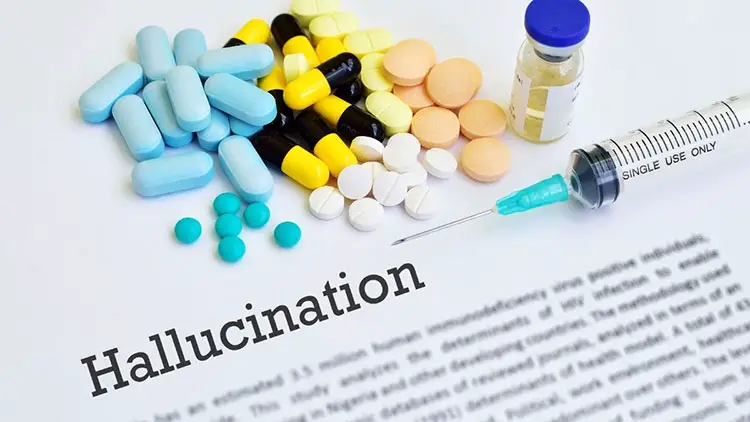Hallucinations in the elderly are false perceptions of objects or events involving the senses. This article will discuss hallucinations in terms of an elderly person – what it means and what might be causing it.
- Hallucinations in the elderly are mostly auditory.
- There may be nutritional causes for hallucinations.
- There are various medical conditions that can cause hallucinations in people of any age.
- Severe dehydration may cause dehydration.
- Dementia and hallucinations are closely linked in the later stages of the disease.
What Does it Mean When an Elderly Person Starts Hallucinating?
Hallucinations are mostly auditory but they may be visual, olfactory (affecting the sense of smell), tactile (affecting the sense of touch), or gustatory (related to taste). Some hallucinations are even musical.
When they happen to your family member, it’s best you start thinking outside the box. Your loved one’s medical doctor will think about the worst medical scenarios that could cause hallucinations but often won’t exhaust the possibilities of why they occurred. A medical professional can really only see hallucinations legally from the point of view related to his or her specialty.
But if you understand more of the big picture of why they occur, you might be the one that literally saves the well-being of your loved one.
When an elderly person starts hallucinating, it definitely means something is wrong. Something is causing images or sounds to seem real when they are not. That could and often does come from a disease process, but it may also be nutritional, from medications, or even a spiritual issue.
Yes, it is true you are not a doctor but you can make sure your medical doctor covers all the bases of medical reasons for hallucinations – neurological diseases and medication-induced hallucinations.
At the same time, your loved one can get a complete nutritional work-up from one or more qualified nutritional health professionals. You must consider nutritional causes if your loved one is suffering from this condition.
Nutritional Causes of Hallucinations
Here’s a case that explains one of the nutritional influences of hallucinations – the levels of magnesium and calcium were off in the body. It was reported in the British Medical Journal Case Reports in 2011.
A 57-year-old man came to the emergency room with profound visual hallucinations. When they tested him, he was severely low in magnesium and calcium. Once he was given supplementation, his hallucinations went away. It was that simple.
In this case, the medical staff worked extra hard to try to decipher what was wrong with the man. They determined that his magnesium levels that were very low caused his parathyroid hormone to also be super low and as a result even calcium levels fell low. Low levels of these two minerals is tied to potential hallucinations.
Other connections with nutrition and hallucinations include vitamin D levels, vitamin B12, niacin, vitamin B1 (thiamine), and other B vitamins. What you may not realize is that all the vitamins and minerals connected with hallucinations are ones that can become deficient in a person who is on different medications. With every dose, the nutrient levels go lower and lower unless something is done about it and until a horrible symptom such as hallucinations occurs.
Always have your loved one tested nutritionally if he or she experiences hallucinations. Print out this article just in case hallucinations occur at some time in the future for your loved ones. It’s always helpful to be proactive – and after all, your loved one is in the age where things seem to mysteriously happen to them, and sometimes it happens quickly.
12 Medical Conditions that Cause Hallucinations
If you obtain help for your loved one to rule out nutritional causes of hallucinations, you can avoid other types of medical testing. Like the 57-year-old man who was found to have low calcium and magnesium levels, your loved one’s episodes with hallucinations can be brought to a quick close.
Visual hallucinations can be medically due to the disturbance of the structure of the brain, a disturbance of neurotransmitters, and emergence of the unconscious into consciousness. To date, no one mechanism of the brain has explained all types of visual hallucinations.
Visual hallucinations are usually vivid family scenes or scenes about religious figures or animals. Sometimes they involve giants. They might cause fear, pleasure or indifference.
Below are the causes of hallucinations that are visual in nature.
1) Schizophrenia
Visual hallucinations have been reported in up to 72% of patients with schizophrenia and other schizo disorders. While this can explain hallucinations in the elderly, schizophrenia is not restricted to older adults.
2) Delirium
Delirium is called sensory misperceptions by psychiatrists. It is often accompanied by hallucinations and delusions and suggest that someone has a psychotic disorder. Among those with delirium, the most common type of hallucination is visual. The more body conditions a person with delirium has, the more likely it is to have visual hallucinations.
Delirium can also occur from alcohol withdrawal. One case history is when a man in his 50s was checked into an alcohol rehab center. It was his first night there when the hallucinations began.
“What do you think we should do about the little green men there in the corner of the room?” he asked the staff. The hallucinations gave clues to the staff that the patient needed to be transported to the hospital for delirium tremens. His body was shaking uncontrollably as well. When he was admitted, hospital staff said that it was the worst case of delirium tremens they had seen in many years.
Intoxication with cocaine or methamphetamine typically causes visual hallucinations. Like with alcohol detox patients, there is usually a report of crawling insects.
3) Dementia
Visual hallucinations occur in more than 1 out of 5 patients diagnosed with dementia with Lewy bodies, the second most common form of dementia. The patients involve seeing objects move when they are actually still and they also see complex scenarios of people and items that are not present. In fact, when a patient has dementia, these visual hallucinations are a way to predict that the type of dementia is dementia with Lewy bodies, not Alzheimer’s disease. Scientists have found that the Lewy bodies characteristic of this type of dementia are found in the amygdala and the parahippocampus, which affects what is seen visually in the mind.
4) Parkinson’s Disease
Up to half of patients with Parkinson’s disease have visual hallucinations that can involve seeing a person or animal up to seeing more complex, formed, and mobile people, animals or objects. It’s similar to the hallucinations found in dementia with Lewy bodies patients.
5) Charles Bonnet Syndrome
Patients with Charles Bonnet Syndrome have visual hallucinations, too. What’s unusual about this is that it occurs in those who are visually impaired. Their hallucinations involve people, faces, animals and inanimate objects. The hallucinations have been thought to be due to cortical activity in the brain. Pre-existing dementia or cognitive impairment may predispose a patient to develop this syndrome. The best treatment of those with this type of problem is to improve their vision.
6) Seizures
Visual hallucinations may be caused by seizures, and are usually small, brightly colored spots or shapes that flash. The objects in the hallucination may be distorted in size or may shape shift and move from the side of the visual field to the center of the field of vision. The seizures that start them involve the visual association cortex in the brain.
7) Migraines
Visual hallucinations are less commonly associated with migraine and estimates are only 15-29%. Nearly all of those who have migraine with aura have visual symptoms. It starts as a flickering, uncolored, unilateral zigzag line in the center of the visual field that moves towards the side.
9) Sleep Disturbances
Patients with insomnia, excessive daytime sleepiness or mental disorders are more likely to experience hallucinations. They are also common with narcolepsy.
9) Drug Effects
Drugs that cause hallucinations include mescaline, psilocybin, and LSD when used in high amounts. Ecstasy, atropine, phencyclidine and dopamine agonists also are considered hallucinogenic. Others have been reported to be related to morphine administration.
10) Tumors
Tumors that are near the optic nerve path can compress the nerve and cause visual hallucinations. It’s estimated that 15% of those with occipital lobe tumors have visual hallucinations and are usually unformed spots or shapes of light. Those with temporal lobe tumors 22% of the time. These are usually vivid scenes including people carrying out mundane tasks and are thought to be related to seizures from the tumor.
11) Inborn Errors of Metabolism
Hallucinations can occur in those with these genetic disorders and are usually associated with Neimann-Pick disease type C, a-mannosidosis, urea cycle defects, GM2 gangliosidosis, and homocysteine remethylation defects.
12) Creutzfeldt-Jakob Disease
In this usually fatal neurological disorder caused by a prion infection in the CNS, hallucinations are found in the latter stages. The hallucinations involve color changes, visual field defects and more.
Here’s a chart to sum up the features and most likely diagnosis:
| Features | Most Likely It’s This |
|---|---|
| Simple patterns, spots, shapes, or lines; unilateral distribution; associated with a headache | Migraine, seizure, tumor |
| Associated with going to, or waking from sleep | Sleep disorders |
| Frightening content | Psychotic disorder, delirium, Hallucinogenic drug |
| Good insight into the content | Charles Bonnet Syndrome, Migraine |
Each of these medical conditions can lead to additional tests, some of them which may be painful. This is why it’s important to hit the medication causes and nutritional causes first.
Can Dehydration Cause Hallucinations?
One case where dehydration caused hallucinations is reported on Psychiatrist.com and tells of a woman admitted to a hospital during a heat wave in New York. The woman was in her 40s, Hispanic and had no prior history of psychiatric disorders or emergency room visits. She had been found wandering in the streets disoriented. She kept her eyes closed during the auditory hallucinations to kill herself. She hadn’t been drinking nor taking drugs of any kind.
She had heard choir music and songs in her head. While hospitalized, she was observed to be very agitated, irritable, and stared at the wall yelling, screaming and calling names out at it. The only medical findings were that she was dehydrated, had low potassium, and an erratic heart rate. The next day, she denied all symptoms once her hydration status was normal. She admitted that she had not been drinking enough fluids. She was released.
The dehydration was thought to cause brain tissue swelling and lead to impaired neurologic functions. It had been accompanied by common signs of dehydration such as sunken eyes, tongue coating, low blood pressure, paleness, and skin that lost its turgor and ability to snap back to ‘normal’.
At What Stage of Dementia do Hallucinations Occur?
Hallucinations in the elderly with dementia don’t occur until the later stages of their disease. The person may see an old buddy in a carpet or curtain or see insects crawling, and it can be frightening to them.
If this happens to your loved one, there’s no point of arguing with him or her. Don’t say that what is reported to you by your loved one is not real. It’s best to simply say you don’t see the same thing, and then reassure the person that they are safe; comfort them. Sometimes moving to another room that is well-lit can cause a hallucination to subside.
Are Hallucinations Common in Older Adults?
Researchers report that because of the negative stigma attached to hallucinations, those who are older tend not to report them to their doctor. Thus, the incidence of hallucinations are considered underreported. It’s still unclear “if hallucination prevalence increases or declines with age in older people”, say scientists studying the matter.
What we do know is that nearly 25% of hallucinations that occur the first time in a person happen after the age of 40. The rates are estimated as low as 0.4% from surveys where surveyed people were asked if they had hallucinations within the last month and up to 37% where people were asked if a hallucination ever occurred in the person’s lifetime.
Hallucinations in the Elderly Summary
If your elderly loved one is suffering from hallucinations, check for medications influencing them. Check for dehydration. Check for nutritional disorders. And check for medical diagnoses.
Stay calm and collect and don’t give up on your loved one until you have exhausted all the possible causes. Your loved one needs you to stand up for him or her and do whatever could be done. You know enough about the topic from this article to figure out a direction.



